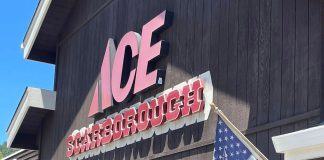
If you have seen strange lights coming from the Quail Hollow sandhills at night and wondered if those were UFOs or American Indian camps, it was probably just Dr. Jodi McGraw. Jodi is the diva of the Forbidden Sandhills — “forbidden” because only scientists are allowed in this fragile ecosystem.
For several months each year, Jodi takes her buckets and lights and goes to count male Mount Hermon June Beetles. Oddly, the insects leave their underground burrows and fly only between 8:45 and 9:45 p.m., lured by the pheromones of the females, who push their abdomens up through the earth to mate. How do they know what time it is?
The beetles are one example of the flora and fauna that are endemic to (or found only in) the sandhills and are endangered by sand quarries and development. You can find the insect listed on international Web sites such as earthsendangered.com.
“From a global perspective, the sandhills are important because of their remarkable concentration of biodiversity,” said Dr. Peter H. Raven, an esteemed botanist who was named a Hero for the Planet by Time magazine. “Because of the patchy nature of the habitat, which resembles an archipelago, I once called it the Galapagos Island of Santa Cruz County, which, if anything, understates its global significance. It affords a remarkable example of the persistence of rare species, of species found beyond their normal distributions, and of evolution in action.”
As you drive through the sandhills on Mt. Hermon or Graham Hill roads, the ponderosa pines you see are not the same ones that grow in the Sierras. Like most plant life in the sandhills, the pines have been so geographically isolated that they have evolved in this place and time and have DNA that you will find nowhere else on Earth. They are so rare that they are not for sale.
Sandhill residents who planted ponderosa pines would introduce a different species, which can cross-pollinate and destroy the endemic species. In this case, botanists believe it is better to plant non-native and non-invasive plants, instead. Even the poppies that grow on the sandhills are unique from all other poppies in California.
Although you can still see Wile E. Coyote in the sandhills, the Roadrunner has been killed off. Like many other ground-dwelling birds, the roadrunner was a victim of cats and habitat destruction.
Another victim could well be the Santa Cruz kangaroo rat, named for the big hind legs that propel the little rodent. Like a gopher, it has fur-lined cheek pouches that it fills with seeds during nocturnal forays into the silverleaf manzanita chaparral.
Environmental groups are lobbying for the kangaroo rat to be listed as endangered, because it can only be found on one parcel in Santa Cruz County, and threats such as cats, bikes and horses are driving it to extinction.
Jodi says that 40 percent of the 6,000 acres of habitat in Santa Cruz has been destroyed, largely through sand quarries and residential development. Less than 250 acres of sandhill parkland remain.
Jodi is not only the premier expert on the Santa Cruz sandhills — she is their guardian and spends at least one day each week tending this rare earth.
If you are ready to journey into the Forbidden Sandhills, join Jodi and me for a walk in Quail Hollow County Park on Sept. 19. Jodi will show us intact sand dollars from 15 million years ago.
You can also ask Jodi about the future of the Santa Cruz kangaroo rat and make other queries, including which large sea mammal from the Miocene period was found in a Zayante sand quarry.
This free walk is sponsored by the Valley Women’s Club Environmental Committee with a grant from the San Lorenzo Valley Water District. For more information, please e-mail me.
Carol Carson has been a docent for Henry Cowell Redwoods State Park and has taught courses on Big Basin State Park for UCSC Extension. She is an environmental educator and a member of the Valley Women’s Club and can be contacted at ca****@*********on.com











